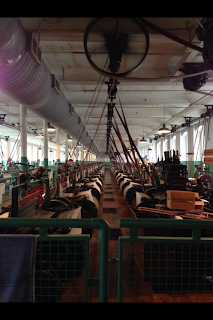Learning
about Jack Kerouac has completely changed my views on Lowell. His story tells a lot about the history of
this great city, and I cannot believe I have not learned about him until now. It was also awesome to see how important
Kerouac still is to the people of Lowell.
Kerouac was
a very interesting man to say the least.
He grew up in Lowell on the second floor of 9 Lupine Road. Throughout his childhood, Kerouac moved to
various different houses in Lowell. My
class and I had the honor of going on a Walking Tour through Lowell. We got to see many of these houses that he
grew up in. It is amazing that they
still stand, just the way he describes them in his novels. As our tour guide read an excerpt at each
location we stopped at, you could see the clear resemblance, and that really
struck me. Every description he read
matched what we were standing in front of.
For a month I have been walking by these different locations with no knowledge
of their history or significance. I’ve
eaten at Suppa’s Pizza so many times, not knowing that just two buildings down
is where Kerouac lived for years.
 |
| These are just a few of the houses Kerouac grew up in. |
The Kerouac Walking Tour started at the Franco American School, down the street from our campus. Behind the school there is a beautiful Grotto and the twelve stages of the cross. Kerouac talked of these figures in his novels. I think that these are very interesting landmarks in Lowell and it is disappointing that they are hidden away behind the school. In one of his novels, he mentioned kneeling at the first stage of the cross and being able to see a particular funeral home in the distance. Standing at the first cross, I could actually see the funeral home. I found this to be exciting.
 |
| The funeral home can be seen in the distance. |
 |
| The Grotto |
 |
| 12 stages of the cross |
 |
| This is a street corner that Kerouac writes about |
We also
went to the Moody Street Bridge where we heard another excerpt from the
guide. I have walked past this bridge so
many times since I have come to school.
Each time I think of how ugly it is, and I was excited when I heard that
it would soon be demolished. The bridge
was described in great detail in Kerouac’s novel Dr. Sax. After hearing the
stories of Jack’s personal experiences on the bridge and seeing how proud and
excited the people of Lowell are about it, I do hope that the bridge is saved
after all. It adds so much character to
the city and it would be a shame if it actually gets removed.
Last
weekend the Lowell Celebrates Kerouac organization put together a festival in
honor of Jack Kerouac. There were many
interesting events constantly going on, and I had the pleasure of going to one. Last Thursday, my friend and I went to the
Traditional Lowell Celebrates Kerouac kick-off music-and-readings event. It was at Cappy’s Copper Kettle, a bar on
Central Street downtown. We weren’t all
that sure if we would get into the event once we realized it was at a pub, but
all of the people were very welcoming and we had no problems. It was a very old fashioned looking bar. There was a small stage in the back corner of
the bar where people were singing. There
was also a pool table where the young men played games all night. These men reminded me so much of Jack, who
spent his nights drinking and playing pool with his friends. It was cool to be sitting in a bar like that
as I listened to excerpts from Kerouac’s novels; it was all very fitting. It also was interesting to me how different
the many people were. There were some
young people, some old, all gathered happily together to celebrate Kerouac’s
life. The atmosphere in that bar was
very enjoyable, and gave me more of an understanding of Kerouac’s lifestyle
that he wrote so much about.
In between
the music and the readings, a member of Lowell Celebrates Kerouac was
honored. Our tour guide from the walking
tour was actually honoring this man. He
was commended for his dedication to the organization. Seeing these men on stage, all dressed in
different Jack Kerouac T-Shirts was just awesome. They are all working hard to preserve
Lowell’s history, and we should all be grateful for that.
I really
enjoyed learning about Jack Kerouac. I
love how his novels were about personal experiences. Even more, I love how I can relate to these
stories and experiences as I walk through Lowell. I now have a much deeper understanding and
appreciation for the city of Lowell. It
is so amazing to me how much this one man was able to shape this city.





















